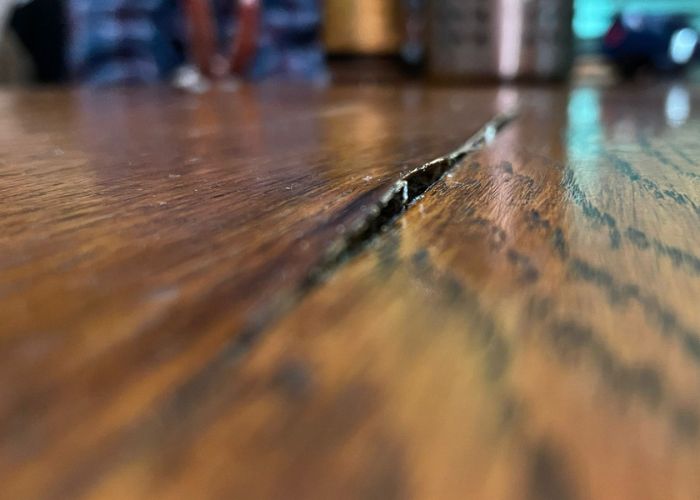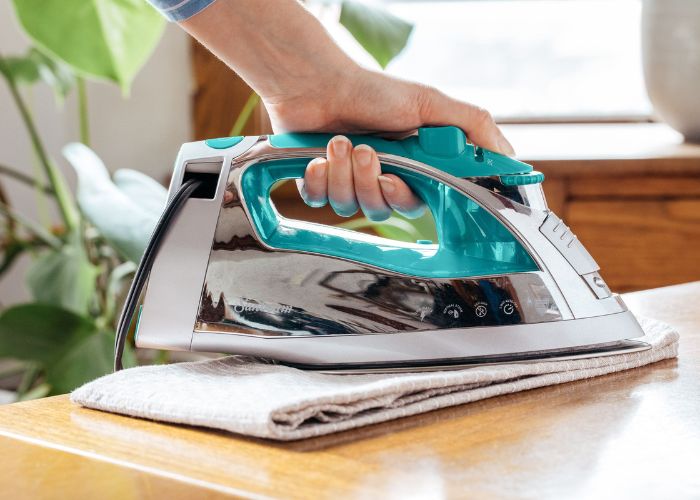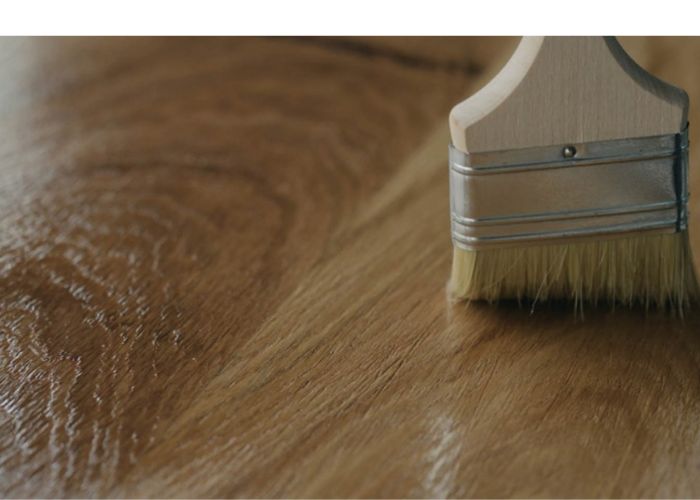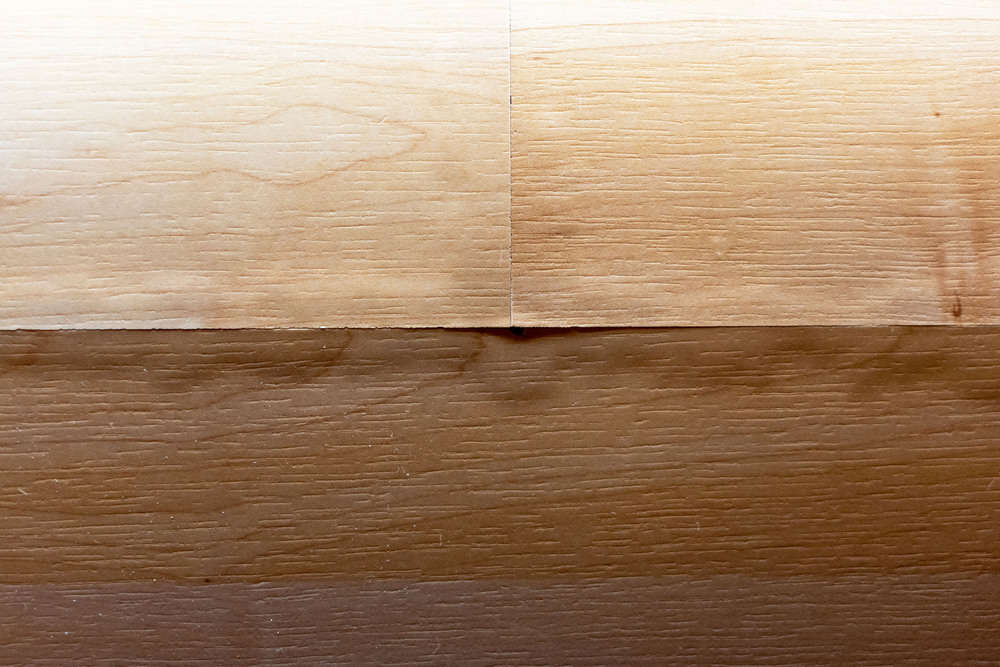Usually, it is difficult to fix things that have been damaged by water. This is because they automatically become weaker, delicate, and prone to further damage by microorganisms or the weather as time passes.
Fixing water-damaged swollen wood furniture seems even more unlikely. However, we will examine how to fix water-damaged swollen wood furniture.
Read on.
How to Fix Water Damaged Swollen Wood Furniture
To fix water-damaged swollen wood furniture, first, allow it to dry by leaving it out in the sun or in a well-ventilated area with blowing electric fans. Another way to dry the wood is to iron it or remove the water bubbles with a needle or a printer. After the wood has dried, assess the extent of damage, then you can move on to sanding the wood, applying furniture oil, and flattening the wood.
How to Fix Water Damaged Wood Furniture in 5 Simple Ways

1. Allow the furniture to dry
Drying is one of the simplest ways to treat water-damaged swollen furniture. Since water is the problem, it only makes sense to remove it from the scene. Allow the damaged furniture to dry.
The most common method of drying wood is to leave it out in the sun. So, you just leave it out in the sun and wait for the water in the wood to evaporate. You can also remove moisture from swollen wooden furniture by wiping it with dry rags.
However, you need to turn the wood around after a while when using this method. This is because prolonged exposure to sunlight might dry the wood out too quickly, leading to shrinking, cracking, and warps.
Another drying process for wood is using electric fans and placing the furniture in a well-ventilated room for at least 24 hours.
After all the water has been removed, you can then place a dehumidifier in the center of the room to reduce humidity in the atmosphere.
Using an electric fan in a well-ventilated area is an excellent way to make water-damaged wood furniture completely dry.
2. Using an iron

Yes, you read that right. Another easy way to fix water-damaged swollen wood is to iron it. Water can cause clear layers of wood to turn creamy or milky gray.
These patches are called water stains or watermarks, and ironing is an effective way to fix this. You will need an iron, ironing board, and a soft cloth for this method. The steps involved are listed below.
Step 1: Wipe off any visible water on wood with a dry rag
Step 2: Plug in the pressing iron to power and set the iron to a low temperature or level of heat
Step 3: Place the soft, clean cloth on the water stains on the wood
Step 4: Iron the swollen wood by pressing it down motionless on the wood for a few seconds
Step 5: Remove the cloth and check the wood periodically to see if the watermark has disappeared
Step 6: Resume ironing till there is no longer any visible swelling or water stains and the wood is dry
However, you need to be extra careful when using the iron. Don’t press the iron down on the wood for too long to avoid burning the cloth or scorching the wood.
Also, ensure the iron is at a low and controlled temperature, as too high temperatures can burn the wood.
3. Using a needle or printer
Using a needle or printer is useful when dealing with furniture that has shrunk after being damaged by water. The damaged furniture may contain bubbles, which can be removed using a needle or a printer.
When using a needle or printer, pierce the bubble from the side, not the top or center, to prevent any overlap of the excess material of the bubble with itself on its sides.
For this method, you will need a needle or a printer, any kind of wood glue, and some wax paper. The steps to follow are as follows:
- Pierce a few holes into the sides of the bubble
- Suck the glue up into the needle and gently push it underneath the water damaged furniture
- Push it down and check for the popping up of the glue
- Though it might cause more cracking, the wood should feel soft when pushed down, and the glue should come out of the cracks in the wood furniture if applied correctly.
- Wipe off the excess glue and lay a piece of plastic over the crack
- Place some books on it and let it dry
- The books should push the veneer down by gluing it down
- Finally, as the glue softens the veneer, it will become flattened
Read: How to stop wood from cracking
4. Sanding and finishing
Sanding is a great way to restore the evenness and flatness of wood. After the damaged wood has been dried, either by leaving it in the sun or ironing, you sand the wood to remove any irregularities or inconsistencies found.
Note that sanding is only advised after the wood has dried and not on wet wood. In fact, before anding, you need to go out of your way to ensure the wood surface is completely dry.
The steps to sanding and finishing water-damaged wood furniture are highlighted below.
Step 1: Prepare the wood surface by cleaning it first before sanding. You clean the wood with a microfiber cloth or scrub brush and cleaning solution to remove any residue or debris.
Step 2: Using sandpaper, sand the wood firmly with even pressure to and fro in the direction of the wood grain.
Step 3: When the wood eventually feels smooth to touch, wipe off all the wood dust and residue with a clean microfiber cloth.
Step 4: After sanding, finish the wood by applying a few drops of furniture oil to it. Rub the oil back and forth into the wood for about 15 minutes to generate warmth that will guarantee the transfer of the oil into the wood.
Step 5: Clean off any excess oil residue with a rag, and don’t forget to wear a dust mask, protective gear, and safety glasses when sanding.
Interesting Read: Cheapest Way to Make Bed Slats
5. Flattening wood
You can fix swollen water damaged furniture by flattening the wood. First, moisten the entire surface of the wood by wetting it evenly with a damp cloth.
If necessary, you can also use a spray bottle or a garden hose as a wood moisturizer. The size and thickness of the wood item would determine the quantity of water you need to achieve this wetting.
Simply put, big chunks of wood would require more water than smaller pieces of wood. However, use water sparingly and repeat the process if necessary.
Next, place the damp board or swollen furniture on a workbench or the top of a counter with the wet side of the wood surface facing down.
This will keep the damp side moist and the dry side exposed to air. Add a little weight on the board or furniture to help flatten the wood and leave it to sit for 24 hours before rechecking it.
Repeat this process if the wood surface is not entirely flat. Also, give the wood some time to stabilize so the wood doesn’t warp.
How to Protect Wooden Furniture From Water Damage
Water damage can make any wood seem unsightly, and we have duly highlighted some steps for you on how to fix water-damaged swollen wood furniture.
But prevention, they say, is cheaper and better than cure. So, here are ways to prevent water damage in the first place.
1. Using oil finishes

Oil finishes do a lot for wooden furniture. They improve the overall appearance of your wood; they also protect it from water damage. An oil finish repels water from the wood surface while also treating it.
The most common examples of mineral oil finishes are linseed oil and tung oil. These oils are also available in different combinations as blend products among other types of wood finishes
Simply dip a clean fiber-free cloth in the mineral oil and rub it on the wood to apply an oil finish. You can also apply an extra polish of mineral oil after it dries.
What’s more, you can oil your wooden furniture as often as once a week or just twice a year, depending on the furniture type.
If you’re looking for a workbench finish, go for drying oils.
2. Sealing
Sealing is a great way to protect wood furniture and prevent future water damage. Sealing helps shield wood and protect the paint from damage from the sun, scratching, fading while also repelling water, dirt, and mildew.
Some examples of wood sealants with excellent water-proofing abilities are polyurethane, varnish, and lacquer. Before applying any wood sealant, clean the wood furniture, sand lightly, and then clean the wood again.
It is also effective to apply another coat of sealant with a clean paintbrush, then leave the wood to dry completely after re-sanding and cleaning it again.
When sanding, wear a protective mask and safety glasses and ensure the wood is dry before re-sealing to avoid air bubbles.
3. Using stain-sealant products
Stain-sealants are combos of wood sealants with added color pigments and oil-based, water-based, or alkyd-based binders.
Depending on the pigment concentration in the stain-sealant product, the final result can be transparent, opaque, or in-between after use.
The stain helps to enhance the beauty of the wood and protect it from the sun’s harmful UV rays, while the sealant in the product makes the wood furniture water-resistant and keeps it from damage and discoloration.
Stain-sealer products should be reapplied on outdoor wood every year to maintain the wood’s protection.
Dangers of Water Damaged Wood Furniture
As an organic material, wood is naturally susceptible to decay and degradation by microorganisms. However, the growth of mold and mildew on wood furniture is accelerated when the wood has been damaged by water.
The first noticeable effect of microbial and organism growth on wood is a general weakness of the wood.
Then, the wood loses some of its physical properties, gets discolored, stained, scratched, and may even begin to smell. Finally, the wood gives up completely, and the furniture is lost.
A timely intervention to fix water-damaged swollen wood furniture either by yourself, using any of the methods we have shown you, or by employing the help of a professional will save you a lot of time, money, and stress.
Treating water-damaged wood furniture is also good for your health. Apart from having an unpleasant appearance, mold on wood furniture can be dangerous to you and your family.
Depending on the mold type, the damp and moldy environment will give off a musty smell that can trigger coughs, allergies, and asthmatic conditions.
Now learn how to get rid of mold on wood in our guide.
Why Does Wood Furniture Swell Up?
Wood is hygroscopic. This means that when the air is humid, wood absorbs moisture and swells, and when the air is dry, wood loses moisture and shrinks.
Wood furniture is likely to swell up in the presence of water. Exposure to high levels of moisture and humidity, for instance, after rainfall or a flood, makes wood begin to swell and warp.
Swelling and subsequent shrinking occur as the wood undergoes changes in its moisture content in response to daily and seasonal changes in the relative humidity of the atmosphere.
A quick way to handle swollen wood furniture is to let it dry. Other methods are ironing, using a needle and printer, sanding and finishing, and flattening the wood.
Related: How to fix a buckled floor
FAQs
How to shrink swollen wood
To shrink swollen wood, first, let the wood dry. You can leave it in the sun or place the wood in a well-ventilated area with blowing electric fans. When sun drying, make sure to move the wood around to avoid prolonged exposure in one part, leading to cracking and warping.
How to repair water damaged tabletop
The extent of water damage to wood will determine the mode of repair. Simply clean the tabletop with a bit of baking soda, white distilled vinegar, toothpaste, or even mayonnaise using a fiber-free cloth to remove water stains. Rub in the direction of wood grain in a smooth motion until discoloration disappears. First, let the swollen wood table dry completely for deep-set stains, then gently apply furniture oil to the sanded wood.
What is a wood swelling liquid?
It is possible to swell wood intentionally, and you can use a wood swelling liquid to do this. It penetrates the wood and causes the fibers to expand. A wood swell (and lock) liquid is usually used to repair wood joints in furniture using swell and lock without having to disassemble the furniture.
How to remove water bubbles from wood
Place a soft, clean cloth on the affected wood and iron it. Be careful not to burn yourself, the cloth, or scorch the wood by not pressing the iron down for too long. Another way to remove water bubbles is using a needle, wood glue, and wax paper to pierce bubbles and flatten the wood.
Can you fix water damaged wood?
Yes, fixing water-damaged wood is possible. The extent of the wood’s damage will determine how you fix it. Some simple ways to treat water-damaged wood include drying it, using an iron, using a needle or printer, sanding, and finishing and flattening the wood.
Will swollen wood shrink?
Wood will shrink naturally in response to a loss in its moisture content. The amount of shrinkage or swelling wood undergoes is approximately proportional to its water level. To make swollen wood furniture shrink, let it dry out in the sun, iron it, or remove moisture using a needle or a printer.
Why does wood swell?
Wood is hygroscopic, meaning it can absorb moisture from the air. In line with that logic, keeping wood furniture in overly humid and moist environments will cause it to swell up. Conversely, wood can lose some of its moisture to the air in arid climates, causing it to shrink.
Here is a guide to the rubber wood furniture pros and cons.
Conclusion
Because wood is an organic material, it is naturally susceptible to decay and degradation by microorganisms. Swollen water-damaged wood is even more prone to the growth of mold and mildew.
Water-damaged wood, if left untreated, can lead to discoloration, staining, scratching, rot, and the eventual loss of the furniture.
A timely intervention to treat water-damaged swollen wooden furniture and remove molds either by yourself, using any of the methods we have shown you, or by employing the help of a professional will save you a lot of time and money, and stress.
Fixing water-damaged swollen wood will also help you avoid risks to your health associated with a mold problem. Remember its sentimental value and do something about your water-damaged furniture today.
Further, read on how to stop a crack in wood from spreading.

